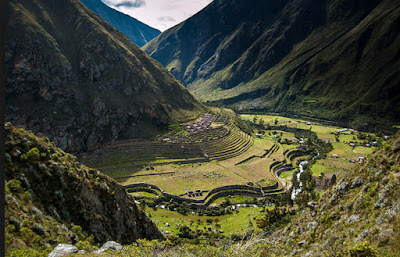Such phraseology would be appropriate in crossing a river though only once that is mentioned, or a mountain, or some other type of terrain that isolated one land or area from another. The suggestion would be, then, that the makeup of the Land of Promise was one that required movement from one settlement, village or city to another by crossing over some type of terrain or object (river, bridge, etc.) to get from one to the other.
These high mountain valleys can only be reached by “crossing over” the
mountains and hills that surround and isolate them
In the 1828 American Dictionary of the English Language, the word “over” is described as “on the opposite side,” “from one land to another.” Today it is defined much the same, “came over” as “they came over from Ireland,” “a person who has come over from one place to another,” “to direct one’s way,” or “to make one’s way.”
The key in the phrase is the word “over,” which means “expressing passage or trajectory across an area” as some semi-obstacle, object, or area. Also, as in “over to this place,” or “over to that place.” In these cases, the object being “crossed over” is understood, i.e., some land form or another, as “in an upward and forward direction across something,” such as up, over and “downward to a flat position,” as in crossing over a hill or a mountain and into a valley, such as “and many of them came over to dwell in the land of Ishmael” (Alma 25:13), or ““he came over into the land of Gideon” (Alma 30:21), or “did go over into the land of Siron,” (Alma 39:3).
As an example, to get to this valley that is
surrounded high hills, one would have to “cross over” through a pass or low
hill to get from another area into this small, secluded valley
In order to get from one side of the canyon
to the other, a person would have to “cross over” this rope bridge to get to
the other side
Such a crossing would be especially true for crossing from one valley
to another over a steep hill or mountain side path, trail or road
In addition, there are cross ranges that anciently were the result of valley glaciers, many separated by only five to six miles, with numerous rift valleys. Because of the tortuous terrain in places, villages and towns in the mountains—to which travel via motorized vehicles today, are of little use—are still located in the high Andes of Argentina, Bolivia, Peru, and Ecuador, often along high plateaus surrounded by even higher peaks that form an unbroken rampart over a distance of 5,500 miles. They are not a single line of formidable peaks, but rather a succession of parallel and transverse mountain ranges, and of intervening plateaus and depressions. Locally, the relatives of the camel, i.e., the llama and alpaca continue to carry out important uses as pack animals, but this use, along with donkeys, mules and horses, has generally diminished in modern times.
According to Thomas Macfarlane, The Andes: A Trip to South America (pp90-91, 1877), The Andes are not a single line of high peaks but rather are subdivided into many smaller units: cordilleras (mountain ranges) nudos, which are cross ranges (sometimes called knots or clusters of peaks) and the altiplano (high plateau), with the north-south cordilleras separated from each other by these knots or nudos (cross ranges), which run across from east to west, combining two main Cordilleras, and separating the hollow lying between them into distinct basin-shaped depressions such as what some call cauldron valleys. In these cross ranges, drainage and rivers sometimes break through, either to the east or west, that also form passes.
“and many of them came over to dwell in
the land of Ishmael” (Alma 25:13), and “and came over near the borders of the
land” (Alma 27:14)
“this man went over to the land of Jershon
also” (Alma 30:19), and “he came over into the land of Gideon” (Alma 30:21
“also came over into the land of Jershon”
(Alma 35:2), and “that they might come over into the land of Manti” (Alma
43:24)
As it is written: “came over unto them;” (Alma 35:9), “and came over into the land of Melek” (Alma 35:13), “did go over into the land of Siron,” (Alma 39:3), “that they might come over into the land of Manti” (Alma 43:24), “and marched over into the land of Manti.” (Alma 43:25), “and brought a part over into the valley” (Alma 43:31), “and came over into the land of Zarahemla” (Alma 47:29), “and came over to the camp of Moroni” (Alma 50:31), and “had come over and joined the Lamanites in this part of the land” (Alma 59:6).
Sometimes when we read the scriptural record, we have something else in mind than what we are reading and the significance of small wordage seems to escape us. It can be most helpful to study out each word and its meaning, each phrase and its intent, and each extended statement and its significance. In this way, we sometimes obtain a better understanding of the terrain and topography of the Land of Promise and, therefore, can see and verify where it is located.











Good observation. It's this kind of analysis that destroys the other models. The Bom writers wouldn't need to use such language in describing a journey in the North America model since there are no high mountains where they claim it happened.
ReplyDeleteNot directly related to this post, or even the wider issue of South American BoM lands, but definately something interesting about the area: http://theonlyperuguide.com/peru-guide/the-sacred-valley/highlights/moray-ruins/
ReplyDelete